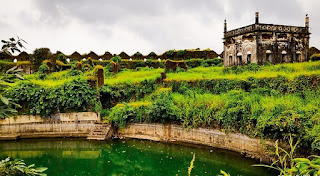Shahaji Raje Defeated Many Kings In Karnataka .
Bhosale is the thirteenth holder of the Chhatrapati title founded by Maratha King Shivaji at his coronation in 1674. Shahaji Bhosale was a 17th century Indian warlord who served at various times in the Ahmadnagar Sultanate, Bijapur Sultanate and the Mughal Empire. his career.
When the Mughals sent an army against him, he took refuge with the governor of Junnar and later returned to serve in Bijapur. During the Mughal invasion of the Deccan, he joined the Mughal forces and briefly served Emperor Shah Jahan. Since then, Shahajahan has sent Shahaji south to avoid trouble.
So let Shahaj face the Mughals alone, he obviously can't because he doesn't have a strong alliance. However, Shahaj will not destroy the occupied territories, but will maintain healthy relations with the Rajas in the surrendered areas. Thus, the peaceful Raja maintained friendly relations with Shahaj and helped Shahaj when he called for military support. At various times, Shahaj was allied with Adil Shah in Bijapur, Nizamshah in Ahmednagar, and Mughals.
In 1659–1662, Shahaji traveled to Pune as an intermediary between Shivaji and Bijapur, meeting his son for the first time in 12 years. Shortly thereafter, Shivaji's marriage to Saibai Nimbalkar of Faltan took place in the palace where Shahaji lived and ruled the city. So, to meet his son and daughter-in-law, Shahaji summoned the couple with Jijabai to Bangalore and repeated the wedding ceremony in his palace. Shahaji was married twice and thus had two children from his first marriage, Jijabai.
With the blessings of Maa Bhavani, Shivaji was born on February 19, 1630 at Shivneri Fort, near the city of Junnar (Pune). Shahji Maharaj Bhosle was first born in 1594 and Sharifji was born in 1596. Shahaji had 3 sisters Jijabai, Tukabai and Narsabai. Shahaji was born to Maloji Bhosle, who had been childless for a long time and was blessed with a child after seeking the blessings of the famous Sufi pir Saheb or Saint Khairat Shah Sharifji. Shahaji was the son of Maloji Bhosale, a soldier who eventually became Sar Giroh and received an independent jagir of Pune and Supe districts in the court of Nizam Shah Ahmadnagar.
Like Maloji Raje, Shahaji Raje Bhosale served in the court of Nizam Shah Ahmednagar. He worked as a general in the court of Adil Shah of Bijapur and Nijam Shah of Ahmednagar. His father, Shahaji Bhosale, was a Maratha general in the service of the Deccan Sultanates.
A member of the Bhonsle clan, Shahaji inherited Puna and Supe jagir (fiefdoms) from his father Maloji, who served Ahmadnagar. He learned martial skills under his father, Maloji Bhonsle. Shahaji treated all his children as good stewards, people of culture and taste: Shivaji in the Pune region, Sambhaji in Banglore and Wenkoji in the Thanjavur region.
However, Bijapur's ruler questioned his loyalty, and Shahaj distanced himself from the actions of his sons. Shivaji claimed to be a servant of the Bijapur government and justified his actions by claiming that he managed the territories better than the deposed ruler.
Thus, the jagir was placed under the nominal management of his youngest son Shivaji, with his subordinate Dadoji Kondadev as his manager. Meanwhile, Shahaji's son Shivaji, who was running his jagir in the Pune region, began to act independently of the Bijapur government and began to seize Bijapur's vassal territories around Pune. He then sent his son Shivaji and his wife Jijabai to Pune to administer the territory.
One day Bhosale sent Shivaji and Jijabai to Pune to take care of Pune's jagir. One day, Bhosale brought Shivaji and Jijabai to Pune to give the impression that Shivaji had begun to take over the Adilshah lands around Pune.
Subsequently, the Mughal emperor Shah Jahan sent Shahaj Bossal to South India. Subsequently, the Mughal emperor Shah Jahan personally led an army to the Deccan, forcing Shahaj to leave northern Maharashtra. Adil Shah released Shahaj from prison amid fears of a new Mughal movement against Bijapur.
He warned Badi Begum of Adilshah that if Afzal Khan and his Adilshahi forces killed Shivaji with trickery, there would be no brick left in Adilshahi's kingdom. Thus, these events prove that Shahaji made a wise decision to keep Shivaji in his original stronghold in Pune, only that Shivaji, like Shahaji, would be imprisoned or killed like his older brother. In June 1674 he was officially crowned Chhatrapati (monarch) in Raigada.
In 1638, he also received the jagir of Bangalore after Bijapur's invasion of the territory of Kempe Gowda III. Ahmadnagar was embroiled in conflicts against the Northern Mughal Empire and other Deccan sultanates, and Shahaji continued to shift his allegiances between these states. When the Mughals sent an army against him, he took refuge with the governor of Junnar and later returned to serve in Bijapur.
To put pressure on Shivaji, the Sultan of Bijapur imprisoned Shahaji Raja Bhosale, Shivaji's father. He was a shining knight of the Bhonsle family and brought laurel to the family. Shahaji Bhosle or commonly known as the father of the great Maratha Emperor Shivaji, formerly known as Shahaji Raje Bhonsle was a general of the Maratha Empire.
Shahaji was born on March 18, 1594 after a long wait for Maloji Bhonsle. Here he spent part of his childhood, but the details of that period are limited and inaccurate. Historical records say that he came to Bangalore at the age of 12 with his mother Jijabai to meet his father Shahaji Raje who then ruled Bangalore. Shahaji Maharaj Bhosle was born in 1594 and Sharifji was born in 1596. Shahaji also had 3 sisters Jijabai, Tukabai, Narsabai. Shahaji Bhosale was a 17th century Indian warlord who served at various points in his career with the Ahmadnagar Sultanate, the Bijapur Sultanate and the Mughal Empire.










0 Comments:
Post a Comment